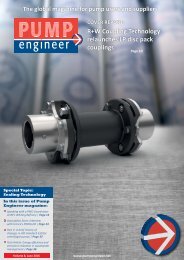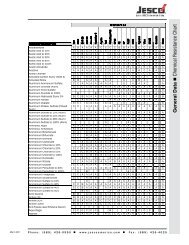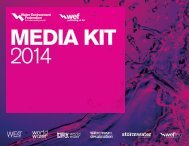KZWja
KZWja
KZWja
- No tags were found...
You also want an ePaper? Increase the reach of your titles
YUMPU automatically turns print PDFs into web optimized ePapers that Google loves.
WIND ENERGY: APPLYING NEW TECHNOLOGY TO AN OLD IDEA97Table 6. Problems and Solutions Encountered by TERA PowerCorporation with the ESI 54 Wind Turbine Generator.PROBLEM ENCOUNTEREDSOLUTIONI) Cracked Transmission Feet a) Design Improvementb) Material Improvementc) Tip Brakes to Reduce Peak Loadsd) Low Power Brakinge) Soft Starting2) Tip Brake Nuisance Deployment a) Electromagnet Tip Mechanism3) Brake Failure a) Alternate Supplier of an IndustrialRated Brakeb) Reduce Braking Demands UsingActive Control of Tip Brakes4) Coupling Failure a) Proper Alignment SpQ ificationb) Accurate AI ignment Technique5) Insect Degraded Performance a) Use the Roughness Insensitive LS(I)Airfoil6)Lower than ProjectedPerformancea) Improved Availability Due to FixedProblemsb) Improved Airfoil Performance inVaried Environmental Conditionselement computer modelling of the foot with predicted loadsapplied. Since the gearbox supplier was responsible for thedesign of this custom housing for their standard gear package,the user had no previous analysis to fall back on.After the foot design was studied, it became clear that thecasting was poorly designed. The web that supported the footwas o/s in thick, while the main portion of the foot was a 1 l/2 inthick cantilevered beam. Since the web was thin, it cooledquickly during casting, forming a fine-grained structure. Thisled to a brittle material. A thicker web would have reducedstresses and improved material properties.Solution. The first, most obvious solution was to changethe foot design to reduce the stresses. A solid web was installedon all new gearboxes and the material was changed to a ductileiron casting. Since implementing this new design, there havebeen no problems. To prevent cracks from occurring on existingunits in the field, a torque bracket has been designed whichshares the torque loads and reduces the foot stresses to 30percent of their original values. This improvement on thelarger ESI 80 (250 kW) machines is shown in Figure 17.Tip Brake Nuisance DeploymentsProblem. The purpose of tip brakes is to slow down therotor speed in overspeed conditions. The first design used a tipbrake deployment mechanism which relied on a shear wire tobreak if centrifugal loads exceeded a safe limit (Figure 18).After deployment in the field, it was found that, in very highwinds, tip brakes would deploy even though no overspeed hadoccurred. Such deployments took machines out of servicewhen they were producing most of their power. The normalresetting of these tips required maintenance personnel to climbmachines in high wind and nighttime conditions.To study the problem, ESI designed a strain gauge transducerto measure loads acting directly on the shear wire. Aftermany hours of monitoring shear wire loads in various windconditions, it was discovered that a 20 Hz oscillating load wassuperimposed on the steady centrifugal load. The amplitude ofthis oscillating load was only a few percent of the steady load inmedium winds, while in high winds it increased to a peak-topeakvalue of 30 percent of steady shearing load. This wasenough to accelerate fatigue in the shear wire. Using accelerometersmounted in the blade, the source of this 20 Hzload was discovered to be a very minor edgewise accelerationin the blade, which excited the shear wire counterweight.These accelerations resulted in forces acting on the shear wire.Figure 17. Improved Transmission Feet on an ESI-80.Figure 18. Old Style Shear Wire Tip Brake or Vane.






